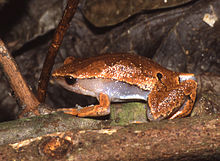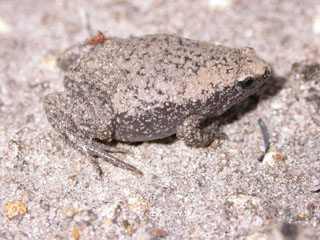
The Microhylidae, commonly known as narrow-mouthed frogs, are a geographically widespread family of frogs. The 683 species are in 63 genera and 11 subfamilies, which is the largest number of genera of any frog family.

Cophylinae is a subfamily of microhylid frogs endemic to Madagascar. It has over 100 species in eight genera. Members of this subfamily range from minute to fairly large, and they are highly ecologically diverse. DNA barcode research has revealed a significant taxonomic gap in this subfamily, and an estimated 70+ candidate species were identified. Many of these have subsequently been described, as well as numerous new discoveries.

Plethodontohyla is a genus of microhylid frogs endemic to Madagascar.

Barygenys is a genus of microhylid frogs. They are endemic to New Guinea and the adjacent Louisiade Archipelago. So far only known from Papua New Guinea, the range of the genus is expected to reach Papua province in the Indonesian part of New Guinea. Despite not being known from Papua, common name Papua frogs has been suggested for them.

Austrochaperina is a genus of microhylid frogs found on New Guinea, New Britain and Australia.

Cophixalus is a genus of microhylid frogs. These are arboreal species with expanded toe-pads, endemic to Moluccan Islands, New Guinea and northeastern Queensland, Australia.
Copiula is a genus of microhylid frogs endemic to New Guinea. The common name Mehely frogs has been coined for them. They are leaf-litter inhabitants.
Hoplophryne is a genus of microhylid frogs endemic to Tanzania.
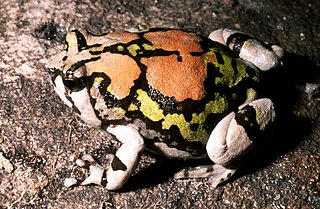
Scaphiophryne is a genus of microhylid frogs endemic to Madagascar. Some of the species are strikingly marked, while others are highly cryptic. They are rather plump and generally found on the ground. Several species in the genus are threatened because of habitat loss and overcollection for the international pet trade.
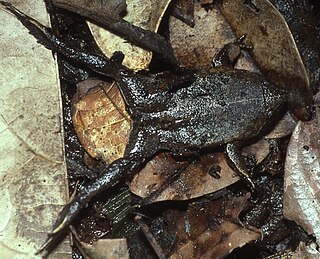
Ctenophryne is a genus of microhylid frogs. They occur in southern Central America and South America. Their common names are egg frogs and Nelson frogs, the latter applying to species in the formerly recognized Nelsonophryne.
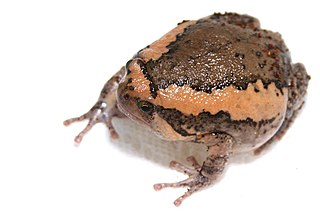
Kaloula is a genus of microhylid frogs found in southern and eastern Asia. They are sometimes known as the Asian narrowmouth toads.
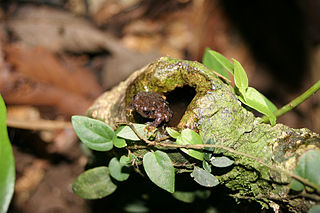
Metaphrynella is a small genus of microhylid frogs from the southern Malay Peninsula and Borneo. They are sometimes known as the Borneo treefrogs or tree hole frogs. The common name refers to the microhabitat of these frogs: males call from tree holes and tadpoles develop in the water contained in those holes.

Otophryne is a small genus of microhylid frogs from northern South America. They are sometimes known as the pancake frogs.

Stereocyclops is a small genus of microhylid frogs. It is endemic to the Atlantic forest of eastern Brazil. Molecular phylogeny suggests that it is sister taxon to the clade containing Dasypops and Myersiella.
Hamptophryne alios is a species of frog in the family Microhylidae. It is known from three localities in the southwestern Amazon Basin of Bolivia, Brazil, and Peru. This species used to constitute the monotypic genus Altigius, but molecular phylogenetic analyses have shown it to be close relative of the then-monotypic Hamptophryne, and the two genera have been merged.
Arcovomer is a genus of frogs in the family Microhylidae. It is monotypic, being represented by the single species Arcovomer passarellii, commonly known as Passarelli's frog. It is endemic to south-eastern Brazil and found in Espírito Santo, Rio de Janeiro, and São Paulo states. Frogs from Espírito Santo may represent another, undescribed species. The name honours Antonio Passarelli who collected the holotype.

Stereocyclops histrio is a species of frog in the family Microhylidae. It is endemic to the northeastern Bahia state of Brazil where it occurs in remnants of the Atlantic forest. After the holotype was collected in 1944, the species went unrecorded until a population was found in the Una Biological Reserve and its surroundings in 1999. It is now known from four locations. Common name Bahia yellow frog has been coined for it, perhaps in reference to the bright lemon yellow coloration of the holotype. It was the only species in the genus Hyophryne until 2012 when molecular data demonstrated that it is nested within Stereocyclops species.

Myersiella is a genus of frogs in the family Microhylidae. It is monotypic, being represented by the single species, Myersiella microps. It is endemic to southeastern Brazil and occurs in Espírito Santo, Rio de Janeiro, southeastern Minas Gerais, and southeastern São Paulo state. The genus name honors George S. Myers. The genus is sometimes known as the elongated frogs, while the sole species is known as Rio elongated frog.
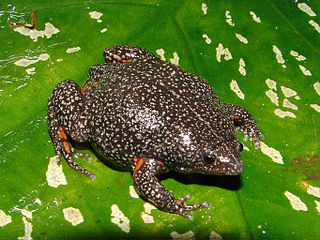
Elachistocleis pearsei is a species of frog in the family Microhylidae. It is found in the Pacific versant of western Panama, Caribbean lowlands of Colombia and into the Magdalena River Valley, and in northwest Venezuela. The specific name pearsei honors Arthur Sperry Pearse, an American zoologist.
Sphenophryne is a genus of frogs in the family Microhylidae from New Guinea. It reached its current composition in 2017 when Rivera and colleagues brought the genera Genyophryne, Liophryne, and Oxydactyla into synonymy of the then-monotypic Sphenophryne. However, the AmphibiaWeb continues to recognize these genera as valid.
